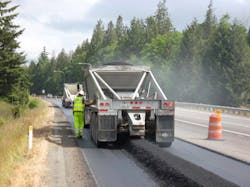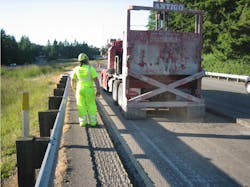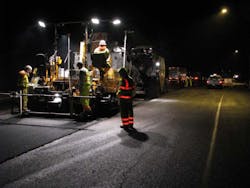In 2010, a stretch of I-5 in Skagit County, Washington, was in dire need of rehabilitation. A 1993 asphalt maintenance overlay proved insufficient, suffering severe reflective cracking caused by the joints of the original underlying concrete pavement. The Washington State Department of Transportation (WSDOT) knew it wanted to opt for a long-term solution while also keeping costs low. Officials found the perfect fit for the job: a crack, seat, and overlay process that included an asphalt pavement “deep strength” overlay, resulting in a long-life, perpetual pavement design. WSDOT’s first “Perpetual Pavement by Conversion” project was born.
Taking a crack at it
Restoring an 11.6-mile stretch of northbound I-5 from the Joe Leary Slough to Nulle Road proved successful thanks to perpetual pavement design. It was WSDOT’s first interstate project to use the methodology, which was chosen in part to overcome extensive concrete panel movement (aka “panel rocking”) at the original pavement joints. Prior to construction, this stretch of road was in notoriously rough shape. Jeff Uhlmeyer, P.E., former WSDOT State Pavement Engineer and current Associate Engineer at Quality Engineering Solutions, said the hot-mix asphalt overlay placed on the road in 1993 had gradually eroded over the years.
“Over time, the roughness reappeared, and the road was requiring lots of maintenance to keep the transverse cracks sealed,” he said. “So that's where this job came in. We had to provide a solution.”
When federal funds became available in 2010, WSDOT jumped at the opportunity to move this project forward under an accelerated design, bid, and build process. In just three months, the department prepared and advertised the design-build contract and ultimately selected Granite Construction Inc. as the contractor.
The project would become a truly collaborative effort between WSDOT and Granite when they co-located as a partnering team for the duration of the job. Roadwork began in April 2011 and was completed that October.
A seamless process
The crack, seat, and overlay process involves fracturing the existing concrete pavement to turn it into a supporting base for a thick layer of new asphalt. WSDOT opted for this method for numerous reasons: it would provide low initial costs, allow for fast construction, and offer long-term value with less disruption to the traveling public.
Jim Prouty, senior project manager at Granite, said the crack-and-seat method was straightforward once everyone got up to speed on the new process. After removing the existing overlay, contractors would crack the concrete roadway with a guillotine breaker to achieve a specified cracking pattern. After a water test to confirm the cracks were spaced properly throughout the panel, they moved on to compacting the fractured slabs with a 50-ton pneumatic roller to thoroughly seat the old concrete on the underlying subgrade. The final step was overlaying it with 8.3 inches of dense graded half-inch Superpave designed asphalt mix.
Workers used accelerated construction techniques to get the job done efficiently. During two 72-hour lane closure periods, contractors worked around the clock to replace approach slabs at several bridges while also performing much of the crack, seating, and overlay. Prouty said these extended lane closures allowed them to get a tremendous amount of work done without interruption.
Immediate benefits
Initial cost savings on this project were substantial. The cost per lane mile for the crack and seat solution was less than a million dollars. By comparison, asphalt reconstruction would have been $1.3-1.5 million per lane mile, and concrete reconstruction would have cost about $2.5 million per lane mile, Uhlmeyer said.
The crack and seat process also allowed for considerable time savings and less impact to the motoring public due to minimized lane closures.
“To be able to rejuvenate the road and get traffic back on it, so that commerce can start to flow again and people can get to work, is a big thing,” Prouty said.
From a sustainability standpoint, Prouty noted that the crack-and-seat process is a great way to recycle material and use existing infrastructure. Instead of rubblizing, excavating, loading, and hauling off the failing concrete, and then rebuilding the pavement from the subgrade up, it was essentially recycled in place with minimal processing.
Long-term performance
The revitalized asphalt road was built with a 50+ year life in mind with minimal periodic surface treatment required every 18-20 years. After 10 years of initial service, Uhlmeyer said this freeway segment is in exceptional shape. The international roughness index (IRI) on the completed project has not changed much since construction, measuring an impressive 51 inches per mile in 2019 compared to an IRI of 48 just after completion in 2011.
In recognition of this long-life design, the Asphalt Pavement Alliance (APA) awarded the I-5 project APA’s inaugural Perpetual Pavement by Conversion award. The award recognizes pavements that are designed to use the existing road structure as an integral design component in building a pavement that will last indefinitely with routine preservation strategies.
Both Prouty and Uhlmeyer said this award was great to receive, especially on a project executed under such a tight timeline. With so many moving parts, Prouty said he’s proud of all the detailed planning and dedication of resources that went into pulling this project off.
“As an entire team, when we all pulled together and put our focus on it, we were able to get it done.” The result is a pavement that can be easily resurfaced and refreshed in predictable preservation cycles, in perpetuity.



